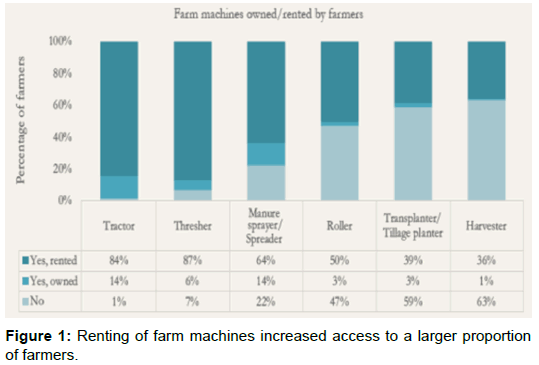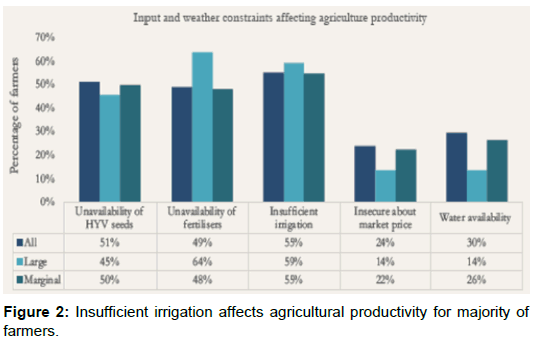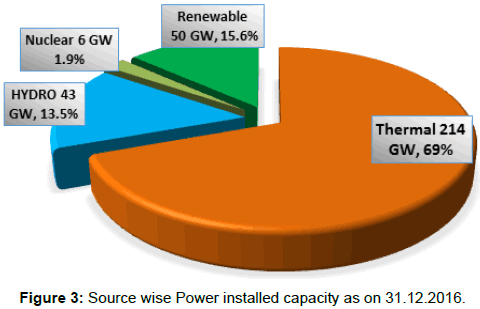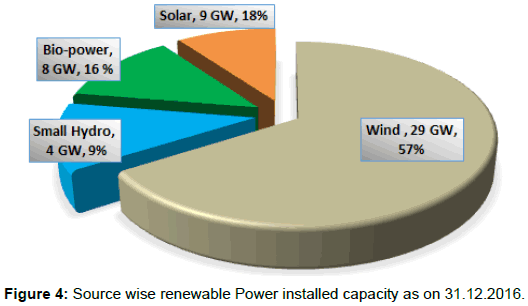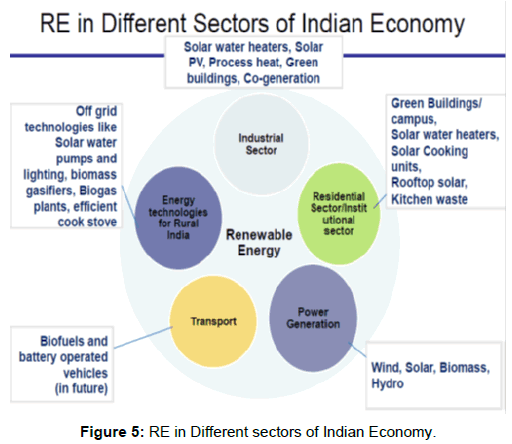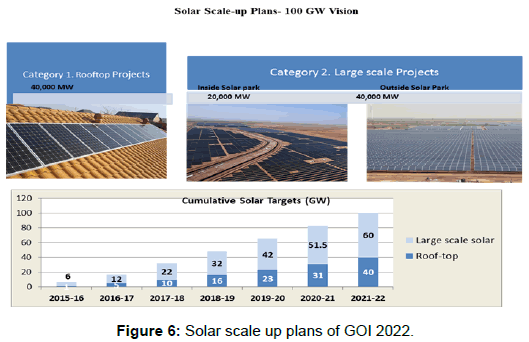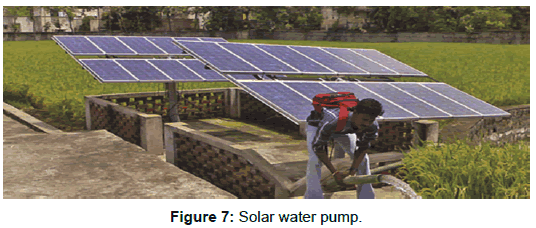Feasibility of Photovoltaic Solar System for Rural Electrification
Received: 25-Apr-2018 / Accepted Date: 14-May-2018 / Published Date: 25-May-2018 DOI: 10.4172/2576-1463.1000204
Abstract
Growth of our nation will totally depend upon rural development. Rural development is the main concern of growth of farmers. Farmers total growth depends upon their basic root cause of traditional farming to mould into advanced farming. Rural development of farmers through awareness of advantages of economical, clean, environment friendly, pollution free, of available renewable energy sources PV based rural electrification system for advanced farming. Rural electrification is an integral component of poverty alleviation and nation growth. Government of India has a target of solar rural electrification for irrigation through solar pumps, solar tractors, solar advanced farming equipments.
Here, this research is helpful for finding out difficulties in rural electrification, awareness of policies, fundings, loan facilities, subsidies and training for the farmers. Also this research indentifies what Steps are to be initiated with Rural Electric corporation, power sector reforms and State Electricity boards. Also this research provides the features of rural electrification in India and the photovoltaic solar farming, solar home systems for rural electrification.
Keywords: Renewable energy system; PV; Wind; Multi objective optimization; Cost effective; Quality of service; Reliability; Rural Electrification; Solar pumps; Irrigation system; Rural development
Introduction
Day by day, the energy demand is increasing and creating huge burden on energy sources. Global climate changes and infeasibility in transmission network in thick forests and hilly areas, such a standalone remote areas where laying of transmission network makes it very uneconomical. Usage of conventional energy sources like coal, fuels are very uneconomical and increases global warming effect due to increased Co2 emission. Therefore, more emphasis should be laid towards use of affordable, clean, environment friendly, easily available energy sources. The main problem solving solution for rural electrification and rural farming is use of solar energy as a solar mitra for farmers by knowing their benefits.
Current Situation of Rural Electrification in India
An important component of integrated rural development is rural electrification. In India, maximum Villages are located away from main grid nearly 3 to 80 km. also rural villages or communities are remotely located in thick forests, hill areas and deserts. The number of households are scattered in range between 2 and 200 with dispersed energy loads. As power demand in villages is quite low and rural domestic consumers are mainly peak time consumers and contribute for poor load factors of 0.2- 0.3. Their income level and paying capacity is low. Previous definition of village was (source: Ministry of Power)- A village will be deemed to be electrified if electricity is used in the inhabited locality, within the revenue boundary of the village, for any purpose whatsoever. Modified definition of village from 2004 to 2005 is-
A village would be declared as electrified if-
a) Basic infrastructure such as Distribution Transformer and Distribution lines are provided in the inhabited locality as well as the Dalit Basti/ hamlet where it exists. For electrification through Non-Conventional Energy Sources a Distribution transformer may not be necessary.
b) Electricity is provided to public places like Schools, Panchayat Office, Health Centers, Dispensaries, and Community centers.
c) The number of households electrified should be at least 10% of the total number of households in the village. Electrical power sector was recognized as one of the Millennium Development Goals in 2000, for the upliftment of the masses and poverty alleviation. The Five Year Plans of Government of India, World Bank, International Monitory Fund, etc. have identified this socially relevant sector and initiated several measures like Electricity Act 2003, Deregulation, Unbundling, Independent Power Producers (IPP), and Electricity Regulatory Commission.
Key Features of Decentralized Electricity Generation over Grid Connection
In india rural electrification is carried out mainly through grid connection. The method of connecting a village to be electrified to the nearest village that has been electrified has led to an inefficient, unmanageable distribution network. This has resulted in the following problems:
1. Average cost of grid connection increases with distance. The effect of T&D losses may further increase the delivered cost.
2. Aggregate and technical losses in India amounts to 50% (source: Central Electrical Authority)
3. Number of average 100 h Customer Hour Lost (CHL) per month due to both scheduled and unscheduled load shedding by grid (source: Central Electrical Authority).
4. Still 157 million households are not having access to electricity (source: Rural Electric Corporation).
5. In India, per capita energy consumption is increasing and is 559 kW h in 2007 (source: Central Electrical Authority).
Therefore the advantages of decentralized electricity generation are numerous, including avoiding reliance on state utilities, which are not able to provide reliable supply or access. Other advantages include decreased reliance on fossil fuel-based electricity generation, decreased loss in transmission, which is currently estimated to be 40% in India, and direct employment opportunities within the villages, the sites of equipment and operation [1,2]. Hence electricity planners are compelled to think of supplementary or alternative electrical energy supplies to these areas. Several options are solar, wind, biofuels, and fuel cells. Indian conditions are best suited for solar energy because of following advantages.
Generation at site, less transmission and distribution losses, Customers are own supplier of electricity through various distribution sources, power generation on an average of clear sunny days in year for 300 days nearly. Reduction in the cost of PV cell, the production of power is environmentally friendly suited for roof top generation and Building Integrated PV (BIPV) the systems are suitable for any part of the India (e.g., under serviced areas) Proven technology of panel, battery and controller solar PV systems are durable and maintenance is easy no fuel cost is involved and electricity is generated for more than 20 years without any traditional fuels.
Objectives and Scope of the Study
The main objective of this study is to contribute to a better understanding of the potential impact and of the limitations of PV systems on sustainable agriculture and rural development, especially concerning income-generating activities.
It is in fact of considerable importance to identify the potential contribution of PV systems to rural development in order to gain further financial and political commitment for PV projects and programmes.
The following research questions were defined:
• What are the PV systems the major applications at present - especially upcoming generating activities?
• What is potential impact of implementing PV systems have?
• What advantages and disadvantages PV systems have in comparison to alternative technologies?
• What is the current status of PV system in terms of extent of use and reliability technical potential and economic competitiveness?
• What new guidelines can be learnt from literature, key persons and project reviews on how to maximize the impact of PV systems on rural development?
This research study also aims to contribute to the understanding of the following premises:
• PV systems can be carriers for small loads of rural socio-economic development. Specifically, the PV system option is investigated for input to rural income generating activities as well as a better tool for social benefits of techno economic analysis in powering applications.
• A number of specific applications of PV systems for productive uses can have high reliability. Technical maturity is not enough though, it must be complemented with support mechanisms for their diffusion (policies, awareness programmes, private sector support, marketing strategies, rural financing mechanisms).
• At least a portion of the power produced by solar home systems, mainly used for lighting and TV/radio, is now a days also powering hidden household-level economic activities.
Renewable Energy and Rural Development
• In India a Agriculture sector have dual importance. It is very essential priority for the nation’s food security and it also provides livelihood to more than 50 per cent of the rural population [3].
• The lack of reliable access to irrigation is one of the biggest bottlenecks in increasing agricultural productivity in India [4-6].
• Despite of homes to electrical pumps of 19 million and about 9 million of diesel pumps, India’s net own area remains unirrigated as per the Agriculture Census 2010-11 of 55% [3].
• On the other side, the adoption of diesel pumps has put undue economic pressure on farmers and also has an adverse ecological impact. In this situation, solar pumps are a emerging alternative solution to access water irrigation system.
• As the SPIS of 100,521 numbers have been installed in India 31 December 2016, out of 38,687 SPIS were alone installed in 2016-17. The high growth in the adoption of SPIS indicating in 2016 [7].
• As we know that for SPIS required a high capital cost, these installations of SPIS have relied on extensive subsidies provided by government. While the government have to do more support in stimulating for solar pumps demands and also in strengthening the ecosystem in market for solar pumps also led approaches supported by market lead approaches for the availability of formal finance for scaling up the deployment of this solar pumping as alternative irrigation solution.
Awareness of solar pumping as a best economic irrigation option with their technology and overall outlook of financial policies on irrigation and agriculture.
We conducted a mixed-method study in the state of Uttar Pradesh (Amethi), to answer the following questions:
• What is awareness level and perception among farmers regarding solar pumps?
• What is their main reason of adopting solar pumps or not? Do their awareness and perception of the technology influence their intent to adopt solar pumps?
• How the identifications among the different size groups of farmers to adopt solar pumps vary. Do the farmers prevailing practices of investment and renting of agricultural technology affect their intent to adopt solar pumps?
• The analysis of the farmers situation of spending expenditure on irrigation system, pumps ownership, and satisfaction to adopt solar pumps?
• What are the farmers views on the adoption of solar pumps under different models such as individual ownership, joint/ group ownership, water-as-a-service from solar pump, etc.?
• What are the challenges faced while availing institutional credit for such financing? What are the basic sources of financing that farmers while adopting solar pumps?
Over the last decades for rural electrification PV system with for decentralized generation has shown its potential as a technology and to improve access to electricity in rural areas of developing countries. Day by day Impressive advances in the field of technical as well as in the organizational, economical and financial fields have been made. The PV systems are being integrated for electrification programmes in different parts of the world for large rural areas of countries like Argentina, India, Mexico, South Africa, United States, and Zimbabwe. In general, PV technology are reaching towards a commercial marketing maturity with economic policies. The growing investments in new production capacity are expected to create the new market conditions for further price drops and higher competitiveness in renewable market.
• The framework of Sustainable Agriculture and Rural Development (SARD) includes its mandatory to improve better the conditions of agricultural productivity for development rural populations. The natural energy and resource management and energy conservation with technological advancement and institutional change to ensure the attainment and continued satisfaction of human needs towards present and future generations. Such as in the agriculture, forestry and fisheries sectors sustainable development of conserves land, water, plant and animal genetic resources is environmentally non-degrading, technically appropriate, economically viable and socially acceptable.
• Some examples of important activities requiring energy inputs in different rural sectors are:
Irrigation system for farmers, land preparation and proper use fertilization in agricultural sector. Domestic lighting, home food processing and conservation, cooking in household sector.
• Industry in rural areas and commercial services sector includes lighting, processing.
• Water pumping, refrigeration for health centers, lighting of communal buildings for community and social services. This study of farmers of in UP, Amethi is focused on solar photovoltaic (PV) systems, which can fulfill only a part of rural energy needs.
• As it has been noted before most PV programmes have given attention towards “Solar Home Systems” as the most proven of PV applications. With continuing and progressive advances in PV technology, by implementing economics policy for decreasing prices of implementation of PV system and day by day growing experience in the organizational aspects of introducing this new technology many other applications of PV have shown their potential. This promises creating a greater contribution of PV systems for rural development.
Major findings in Rural farming of Amethi, UP (India):
• It’s very big challenge for providing a reliable and affordable access of electrical energy for irrigation in rural places of UP. The farmers surveyed mention here as 55% of insufficient irrigation which acts as the biggest bottleneck to increasing incomes from farming. Also, the farmers reported limited availability of water for irrigation is of 30% of as a challenge.
• The climate change in given metrological station will also effect on sudden need of water for irrigation is increasing to adapt to the changing climate manifested through warmer summers and decreasing rainfall.
• 60% of marginal farmers are depend on buying water. The renting pumps to meet their water irrigation needs is the costliest option for irrigation. While the estimate for the number of irrigation diesel pumps in the country varies from six to nine million, as many as 30 million farmers reported using them for irrigation, as of 2012. This indicates a high degree of sharing of diesel pumps.
• Bore well ownership is skewed towards large and medium farmers and decreases with decreasing size group. Only 41% of marginal farmers have reported their owning a bore well as compared to % of large farmers.
• The farm equipment including pumps on renting is a common practice among farmers that has increased farmers access to technology. Also we found that while only 14 per cent of farmers owned a tractor, almost 99 per cent of them reported using one. We also found that the existing owners of farm machines, typically medium and large farmers, are more likely to invest in newer technology in the future to be able to rent them out.
• While the farmers reported having irrigation access on all sections of their land are 86 percent of, and the farmers who satisfying with their current irrigation situation are of only 51 percent. Depleting water tables and high expenditures on diesel were two major reasons behind farmers dissatisfaction. Those dissatisfied with their current irrigation arrangement had 26 per cent higher odds of adopting solar pumps than those satisfied.
• Awareness of solar pumps is abysmally low among farmers. Only 27% of farmers have heard of SPIS, the farmers who have seen solar pumps in reality are 14% or on television and only 2 per cent of them have heard about the government schemes on solar pumps.
• Therefore, we found that farmers perception of the successful operation of a solar pump increased with actual demonstrations of its use. Further, a farmer who had seen a working of solar pump in action. This type of real demonstrations creates positive views about its successful operation.
• About 41% of farmers were interested in adopting solar pumps. Due to very less or zero operational cost and convenience of use of PV system maximum farmers creating their interest in adopting solar pumps. Whereas, the high capital cost of solar system was the main reason behind those not interested in adopting one.
• Our regression analysis revealed that the strongest determinants for the adoption of solar pumps were the practice of agriculture as a primary source of income, farmers future investment plans for renting out farm machinery, and their awareness and views on SPIS.
• The Willingness-To-Pay (WTP) for solar pumps was quite low compared to conventional pumps and on average varied from 12 to 30 per cent (varying with the size of the pump) of the market price. Small and marginal farmers showed lower WTP than large and medium farmers. To purchase solar pumps, their own savings, and credit from banks were the two main sources of finance available to farmers.
• The interested farmers in the joining the ownership of solar pumps are about 20 percent of and the potential adopters are 39 percent. Compared with a higher proportion of small and marginal farmers were interested in opting for the joint ownership model.
• About 80 percent of farmers were willing to buy water directly from a solar pump run by a private entrepreneur, provided the price was competitive to prevailing local water market prices.
• Awareness of efficient irrigation practices and micro-irrigation was very low. None of the farmers surveyed were using drip or sprinkler irrigation, less than a quarter had heard about them, and only seven per cent farmers were willing to adopt either practice.
Key Policy Recommendations
1. Focus on creating awareness among farmers on generation and technology demonstration. It is necessary to deploy at least five to ten solar pumps in each block of the Amethi, prioritizing regions with better groundwater availability to enable demonstration effect to yield bottom-up demand. Ministry of New and Renewable Energy should consider engaging with channels already reaching out to farmers, such as the Ministry of Agriculture and its extension services, bank correspondents, and agricultural assistants for awareness generation.
2. Improve the number of farmers targeting of prevailing government support schemes on solar pumps. Focus on marginal farmers by promoting smaller (sub-HP to 3HP) solar pumps through capital subsidy.
3. Encourage the deployment of innovative approaches among farmers such as solar-powered water as a service model and the joint ownership model to cater to marginal farmers.
4. It is important to consider the pattern of bore well ownership while framing policies to support solar pumps, otherwise, the targeting of policy support could remain significantly skewed towards medium and large farmers.
5. There is need to government, MNRE should to do work with banks and financing institutions to develop a suitable financial products to fulfill needs of farmers. Also, it’s very necessity that the banks must simplify processes of loans and maintain standardize, to provide pro-active support to avoid harassment of customer during loan applications.
6. It is important to consider the pattern of bore well ownership while framing policies supporting solar pumps, otherwise the targeting of policy support could remain significantly skewed towards medium and large farmers.
7. MNRE should closely collaborate with Ministry of Agriculture and Ministry of Water Resources to enable adoption of efficient irrigation practices and effective management of water resources.
8. Deployment of solar powered devices for irrigation systems should focus on sales services. While operational successfully demonstration of solar pumps has a positive effect on adoption of solar pumps and scale-up of the market.
The solar irrigation systems have a great potential to enhance irrigation access in rural areas, emission in low carbon agriculture equipments to reduce global warming effect also to reduce a burden of electricity subsidies on governments and improve resilience of farmers against a changing climate. The government have adoption of the specific deployment strategies to scale up solar pumps, improvement in targeting subsidies, adoption of a customer-centric approach and focusing on improving awareness about the technology with a social context and concern of environmental situation would help to achieve a sustainable deployment of solar pumps for irrigation of rural development.
Data and Methodology for Implementation
We employed a mixed-methods approach for gathering data for the study. The approach considered here are:
I. A review of the relevant literature on the adoption and financing of solar pumps to gain an understanding of the existing challenges and knowledge gaps
II. A focus on group discussions among (FGDs) the farmers to obtain their perspectives views on capital money investment and renting practices, also gaining a knowledge of the available irrigation situation, also availability of institutional credit and their awareness and views on solar pumps;
III. A quantitative survey of farmers to collect primary data on the themes that emerged during the FGDs.
Selection of State and Districts for the Study
Given the constrained resources available for conducting a survey of 1,200-1,600 farmers, we deliberated on various possibilities regarding the selection of the state and various districts within it. From the different options, we finally selected Amethi, Uttar Pradesh. The choice of the state was mainly guided by the following sets of considerations:
i. UP is the most populous state in the country (equivalent to the sixth largest country in the world by population) with the largest number of farmers and with a primarily agrarian rural economy. It shows significant variation in agro-climatic conditions, groundwater development, economic situation of farmers, and cropping pattern across the state. The variations exhibited within the state represent sufficient diversity of contexts of and constraints on, the resources required by farmers.
ii. High potential for the sustainable deployment of solar pumps in the state as estimated using a multi-criteria decision support tool [4-6] and
iii. Literature indicating the vast potential in the state for the utilization of solar pumps for irrigation [8].
The districts for the intervention were then selected based on purposive sampling. The approach enabled the inclusion of districts exhibiting sufficient variation in the following parameters:
• Use of diesel pumps
• Agro-climatic zone
• Development of groundwater resources
• Cropping pattern
• Economic situation of cultivators
Focus Group Discussions (Fgds) with Farmers
i. We started on conducting one Focus Group Discussion (FGD) with a group of 10-12 farmers in each of the selected Amethi districts. We began by conducting four pilots in two districts of UP to test the FGD design and prompts with the intended target audience. Some Villages were selected through simple random sampling at the district level and the farmers were chosen on the basis of inputs received from local resources while keeping the representativeness of the groups in mind. The discussions focused on understanding the farmers overall outlook on farming (as a source of livelihood and as an enterprise), farm mechanization, access to and expenditure on irrigation, current financing options, views on institutional credit, and views on the solar pump as a potential option for irrigation.
ii. The data gathered at these meetings were fed into the design of our survey questionnaire and more importantly, they also served to further enrich and validate the quantitative analysis based on the survey findings.
The findings from FGDs and the gaps we had identified in the available literature were central in identifying the key themes for the survey instrument. The instrument evolved through several rounds of revisions, with critical inputs from pilots conducted to confirm the ease of administration and the ease with which respondents could follow the questions.
The final questionnaire (designed to be completed in about 40 minutes) focused on the following themes:
• Household demographics
• Perception of climatic conditions and their effect on agriculture and agricultural productivity
• Land profile, cropping pattern, state of mechanization
• Condition of farmers for investment on expenditure and satisfaction of the prevailing irrigation situation
• Awareness of and views on adoption of and WTP for solar pumps
• Access to financial services, financial situation, and experiences with formal lending institutions
Outlook on Investment and Renting Models and Mechanization
The farmers in our survey have average size of landholding was 3.4 acres against the state average of 1.9 acres as per the Agriculture Census 2010-11; the positive difference here could be attributed to our sampling strategy. Close to 86 per cent of the respondents pursue agriculture as a primary source of income for themselves. The farmers surveyed here able to harvest at least two crops in the last year are of 75%. The mean cropping intensity was 1.8 for the state, with almost no variation across size groups, an interesting finding. About 15 per cent of farmers reported growing crops in all three seasons (monsoon, winter, and summer). Only one-third of the farmers cultivate a continuous piece of land and almost half of them have their land divided into three or more pieces, which are typically situated between 0.5 km and 1.2 km from each other. It is important to understand the prevalence of ownership of land in fragments, as it may reduce the utility of the solar pump, given the limited mobility of this device.
In terms of the economics of agriculture, farmers exhibited significant variation in their input costs and incomes. The median annual operational expenditure was close to INR 25,000 in 2016, ranging from INR 0 to INR 500,000. The median income from farming for the sample was around INR 28,000.4 It is important to understand the basic cash flows of farmers, and the variation therein, in order to contextualize the investment required for solar pumps, which is of the order of INR 50,000 for a 0.5 HP pump to INR 450,000 for a 5 HP pump. Compared to other states in India, Uttar Pradesh has a high level of farm mechanization [9]. During FGDs, farmers expressed a strong consensus on the contribution of mechanization in improving yields, increasing time savings, reducing drudgery, and decreasing reliance on draught animals.
The literature views expressed here are indicating an increase in productivity of up to 30% and an increase of 15-20 per cent in time saving due to use of efficient use of advanced farming mechanization [9].
The most widely, highly adopted mechanization and technologies are the tractors and threshers with 99% and 93% farmers are using them respectively as shown in Figures 1 and 2. The extent of advanced mechanization used across different stages of cultivation from sowing to harvesting and across different kinds of equipment.
Awareness of Renewable Policies in India
Power sector have a very vital role in the growth of Indian economy.
• The total installed generation capacity has reached to 310 GW. The generation includes a mix of 69.4% of Thermal, 13.9% of Hydro, Renewable energy of 14.8% and 1.9% of Nuclear energy. The renewable power has secured 2nd position after Thermal energy and renewable energy is spreading its wings rapidly in India.
• The Government of India has up scaled the target of renewable power capacity to 175 GW which includes 100 GW from Solar, 60 GW from wind, 10 GW from bio-power and a 5 GW from a small hydro power achieved by 2022.
• The Ministry is implementing a wide range of schemes with fiscal and financial support and conductive policies to achieve this target.
• Largest of 3423 MW of wind power capacity, 43% of exceeding target by and solar power capacity addition of 3,019 MW, 116 of exceeding target was made in 2015-16.
• For the first time the largest solar power projects capacity of 20,904 MW was tendered and 31,472 Solar Pumps were installed which is higher than total number of pumps installed during last 24 years in 2015-16.
• The Ministry of New and Renewable Energy of (MNRE) [10-12] is the main nodal Ministry for all matters and cases which are related to new and renewable energy at the federal level.
• The Ministry has been facilitating the implementation of broad spectrum programs including harnessing renewable power, renewable energy to rural areas for lighting, cooking and motive power, use of renewable energy in urban, industrial and commercial applications and development of alternate fuels and applications (Figures 3 and 4).
Renewable Energy Schemes for Solar System
• A visible impact on the Indian energy scenario during the last five years. During the last few years in Renewable energy sector of the landscape in India has witnessed tremendous changes in the policy framework with accelerated and a new plans to increase the contribution of solar energy.
• The renewable energy now playing a significant role, as new advancement in technology renewable, power electronics and inverters with confidence in increase of capacity and fruitful applications. Enlarging additional scope of vision of the National Solar Mission for the future. The last five years activities under the solar Mission are height lights great transformational changes.
• India has taken introduction of the concept of solar parks, launching of a massive grid-connected rooftop solar programmes, benchmarking of Rs.38,000 crore for a Green Energy Corridor are several initiatives taken during the last two years.
• Solar pump installation of targeting 100,000 solar pumps in numbers under scheme also training programmed includes a solar installations skill under the scheme of Surya Mitra to train 50,000 people.
• The other significant initiatives are launching of improved cook-stoves initiatives, initiating coordinated research and development activities in solar PV and thermal, second generation biofuels, hydrogen energy and fuel cells, etc.
• The government has a goal to increase the share of clean energy through a massive thrust in renewable energy sources.
• The core drivers for development and deployment of new and renewable energy in India have been Energy Security, Electricity shortages, Energy Access, Climate change etc.
Renewable Energy Potential in India
In the recent years the Programme of Renewable Energy sources has received a wide recognition through worldwide market. Many countries are contributing a interest in cooperation for promotion of new and renewable energy with India. Now our country India has a wide experience and expertisation in renewable energy sectors and promoting an applications of renewable energy for grid interactive systems and off-grid or stand-alone rural development applications of renewable energy to meet electrical energy demands (Figure 5).
Renewable Energy Target
The Government has a scaled up the target of renewable energy capacity to 175 GW by the year 2022. The contributions are includes as follows:
• 100 GW of power generation from solar energy sources
• Wind power generation of 60 GW
• Bio-power generation 10 GW
• A small hydro-power generation from 5 GW
• The target of power generation under the National Solar Mission (NSM) will principally comprise of of 100 GW capacity which contributes 40 GW through Rooftop solar plants and 60 GW through Large and Medium Scale Grid Connected Solar Power Projects.
Solar Farming is Key Solution
The solar pumps are a great potential solution for insufficient irrigation problem, crisis's of limited sources of water availability which is a significant barrier to farm production. In such rural areas solar pumps are very useful only if they are coupled with water-harvesting solutions at the farm level.
The solar pump is often considered to be both a climate-mitigation as well as a climate-adaptation solution (by building resilience against drought). The literature suggests that changing climate—as seen in increasing temperatures and the late arrival of the monsoon-is already affecting agricultural productivity in India [13]. To understand the perspectives on the prevailing climatic conditions and the effect such conditions on rural agriculture farming. Three-fourths of total farmers cited through drought or insufficient rain falls are the main adverse climatic factors affecting on their agricultural productivity. The untimely rainfall of 44% and flooding or excessive rain causes of 22% on productivity of farmers. As mentioned, the rise in average temperature as adversely affecting their agricultural productivity of 10 percent of farmers.
Mini-Grid Solar Power Plants on Full Government Grants
A Mini-grid Solar Power Plant a capacity was installed of 250 KW under this program. Pilot project installed in Village, Fakirpur and Chanduahar Dist. Kannauj in year 2014-15. The electricity generated through the minigrid plant is supplied to domestic connections of 332, commercial connections of 14, irrigation pumps of 11 and street lights of 40 in both villages.
Solar pump is a useful device for irrigation. It works throughout a day 8 am to 6 pm duration of time. On a sunny day a discharge output of this pump is 1.40 lac liters (Maximum). The photovoltaic modules generate D.C power through solar radiations. The Power output of a 2 H.P.D.C. mono block pump operates (Figure 6).
Solar Photovoltaic Pump (Water)
In Amethi districts many rural villages, where there is a lack of clean drinking water, the installation of the solar pump for public use at panchayats/parks is being made on the allocated sites. These plants are eligible for grant by the Government of India. After plant is installed, related operation and maintenance expenses are borne by the concerned village panchayat/parks. From the beginning years, a total of 250 plants have been set up with grant or without grant (Figure 7).
Under the Rural drinking Water scheme installed 3 Phase AC submersible pumps of various rating set up by the Corporation are being powered through solar power plants and control systems.10 HP 3 phase AC submersible pumps of each of 7.65 Wattage. Set up by Water Corporation in village kaluwapur in district Lakhimpur Khiri and village mahai in district Unnao are being powered by installing solar panel and control systems. Based on the success above, Water Corporation has powered total 41 pumps of 5 HP, 6 HP, 8 HP, 10 HP, 15 HP, 20 HP and 25 HP have been powered on similar lines. 70 percent amount of the value of the above work is provided by the water corporation. Remaining funds has been given by the Government of India. Total 41 solar pumps have been powered in rural villages of districts of Amethi, Rae Bareilly, Balrampur, Lakhimpur, Sitapur, Unnao.
Conclusion
The unpredictability of climatic conditions is changing throughout year and has affecting on agriculture growth in rural villages of Amethi in UP, India. The issues like changing rainfall patterns, rising temperatures and declining groundwater levels are major challenges that are already confronting farmers and are likely to intensify in the future. Marginal and small farmers are the worst hit, with their limited resilience against adverse climatic conditions, excessive expenditure on irrigation and poor purchasing capacity to adopt climate adaptation technologies like solar pumps [14-20].
While the government has taken a significant efforts to support the adoption of SPIS by farmers. The review study highlights that the need of our country to better target the support among small and marginal farmers. We need to go beyond the conventional realm of the product ownership based adoption of model of SPIS to look at alternative deployment approaches, such as irrigation as a service and joint ownership of SPIS. Better targeting and innovative deployment approaches need to be complemented by greater awareness of generation among farmers through conducting Farmers Group Discussion (FGD), awareness of technology demonstration of Solar Pumps, Solar roof tops. This also improves a strong and positive perception towards renewable technology. This encourages a longterm adoption and sustainability among farmers. In addition to this, the banking sector needs to support farmers by simplifying their loan processes as well as their communications by extending proactive support to all rural farmers, including hand-holding through the loan-application process, the documentation process, and the creditdisbursal process and by developing financial solutions to cater to the SPIS market through different deployment approaches.
It is important to begin with a undertaking a pilot projects for various adoption models in different contexts to learn from ground experience and then to scale them up further implementation. While the present study endeavors to support the pursuit of scaling up the adoption of SPIS by highlighting the gaps and by describing the way forward, there is certainly a need to test and validate some of the findings in other agro-ecological and socio-economic contexts in order to gain a richer understanding of the realities across a country as vast and diverse as India [20-27].
References
- Mukherji A (2007) The energy-irrigation nexus and its impact on ground water markets in Eastern Indo- Gangetic basin: Evidence from West Bengal, India. Energy Policy 35: 6413-6430.
- Mukherji A (2007) Implications of alternative institutional arrangements in groundwater sharing: Evidence from West Bengal. Economic and Political Weekly 42: 2543-2551.
- Agrawal S, Jain A (2015) Solar Pumps for Sustainable Irrigation: A Budget Neutral Opportunity. New Delhi: Council on Energy, Environment and Water.
- Agrawal S, Jain A (2016) Sustainability of Solar-based Irrigation in India: Key Determinants, Challenges and Solutions. New Delhi: Council on Energy, Environment and Water
- Agrawal S, Jain A (2018) Financing Solar for Irrigation: Risks, Challenges, and Solutions. New Delhi: Council on Energy, Environment and Water.
- Purohit P, Michaelowa A (2005) CDM potential of SPV pumps in India. Paper 4. Hamburg, Germany: Institute of International Economics.
- MNRE GoI (2014) Installation of 10,000 nos. of solar PV water pumping systems for irrigation purpose implemented through NABARD throughout the country.
- MNRE GoI (2014) Supplementary Guidelines for Implementation of Solar Pumping Programme for Irrigation and Drinking Water Off-Grid and Decentralised Solar Applications Scheme.
- Ballabh V (1987) Decline of a novel experiment: A case study of group irrigation tube wells in Deoria District. Anand: Institute of Rural Management, unpublished report. GEDA. n.d. Breaking new grounds in clean energy. Gujarat Energy Development Agency.
- Kishore A (2012) Solar pump project in Rajasthan: A First Information Report. Anand: IWMI-Tata Program, unpublished memo.
- Community tube well: An organizational alternative to small farmers' irrigation. Economic and Political Weekly 19: 59-66.
- Shah T (1993) Groundwater markets and irrigation development: Political economy and practical policy. Bombay: Oxford University Press.
- Shah T, Banerjee PS, Roy A, Singhania S (2012) Coping with seasonal peak in power demand for irrigation: Pros and cons of temporary farm power connections in Madhya Pradesh and West Bengal. Anand: IWMI-Tata Program, Water Policy Research Highlight.
- Tiwary R (2012) Anand: IWMI-Tata Program, Water Policy Research Highlight# 27.
- SSEF (2018) High-level impact of Ministry of Renewable Energy’s (MNRE) solar water pump scheme in 4 states. New Delhi: Shakti Sustainable Energy Foundation.
- Foster DA, Rosenzweig RM (2017) Input Transaction Costs, Mechanization, and the Mis-allocation of Land: The Irrelevance of the IR.
- Gaurav S, Mishra S (2011) Size Class and Returns to Cultivation in India: A Cold Case Reopened.
- Hollinger F (2004) Financing Term Investments in Agriculture: A Review of International Experiences.
- Kishore A, Shah T, Tewari PN (2014) Solar Irrigation Pumps: Farmers' Experience and State Policy in Rajasthan. Economic & Political Weekly 49: 55-62.
- KPMG (2014) Feasibility Analysis for Solar Agriculture Water Pumps in India.
- Ministry of Finance GoI (2016) Economic Survey 2015–16. Department of Economic Affairs, Economic Division. New Delhi: Ministry of Finance.
Citation: Sutar C, Singh D, Verma KS (2018) Feasibility of Photovoltaic Solar System for Rural Electrification. Innov Ener Res 7: 204. DOI: 10.4172/2576-1463.1000204
Copyright: © 2018 Sutar C, et al. This is an open-access article distributed under the terms of the Creative Commons Attribution License, which permits unrestricted use, distribution, and reproduction in any medium, provided the original author and source are credited.
Share This Article
Recommended Journals
Open Access Journals
Article Tools
Article Usage
- Total views: 4635
- [From(publication date): 0-2018 - Nov 23, 2024]
- Breakdown by view type
- HTML page views: 3861
- PDF downloads: 774

